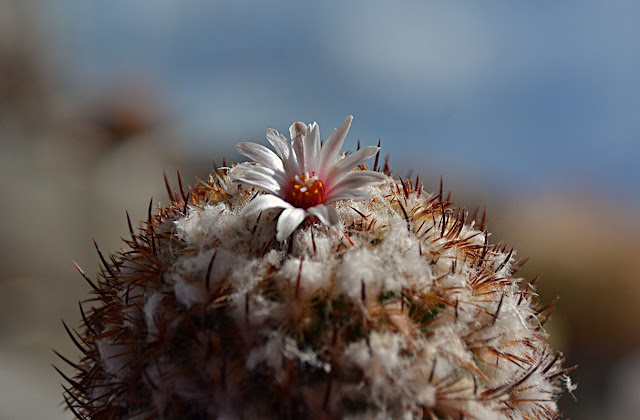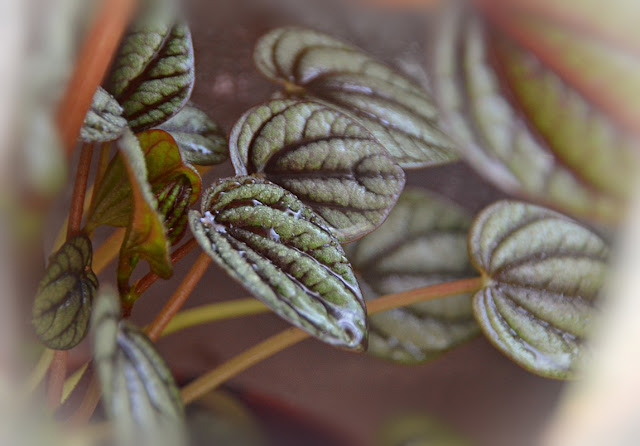I have to confess: although I like tropical plants, I don't have the best track record with them. Long term I do better with cacti and succulents, as I tend to be an erratic waterer. I've been realising, though, that the problem is not only or primarily an issue of watering: rather I think it becomes about soil! Typical houseplant nurseries use sterile substrates which are generally fertilised with each watering. Many of these mixes do not hold up long- breaking down and compacting, becoming difficult to wet evenly, and/or to dry out properly. Compacted peat, can remain dry in the centre of the pot, leaving roots without moisture. Other mixes may lose texture ending up goopy with a lack of aeration in the soil, and plants which are not adapted for water-logged soils have difficulty absorbing water without oxygen in the soil. Either way you end up with plants unable to take up enough water, with roots that may be dried out/atrophied or rotting. Commercial growers avoid this by repotting regularly.
With cacti, succulents, seasonally dry bulbs etc, I have usually changed the soil they arrive in, opting for a mix based on natural clay/loam, gravel and some humus (depending on what sort of habitat they come from, nearly all mineral to more organic). A plant potted in this sort of substrate still needs repotting occasionally to replace soil lost through watering, re-aerate, replace any organics etc ( and I have a whole bunch of plants that are long overdue for renewal!!) but the time-frame is much longer than the peat or bark-based soils used by mainstream nurseries. So what this has meant for some of my unfortunate tropical plants is that while they may tolerate my inconsistent watering (many would prefer some dry periods over constant wetness), once the soil has degraded, if I don't realise and just think-Oh, the poor thing is dry, needs more water!- they may soon reach the point of no return from root loss.
I recently came close to this with a plant I purchased last year(?) Murdannia loriformis Bright Star (note: I haven't yet been able to learn whether the cultivar name applies to a sport of the natural species- which has narrower, all green leaves, or a hybrid or a misnamed closely related species- you really can't take horticultural names at face value! In fact, I bought this plant with a label which said it was a completely different plant in the Commelinaceae family- a Tradescantia or something). This one was remaining wetter than I realised, and lost most of it's roots to rot. Luckily I realised in time and was able to save all of the pieces of the plant. Here's a video of the late night emergency repotting, plus some talk of the native soils I use and other thoughts on potting. Bonus clips/shots of the healthy plants weeks later.
Another plant that suffered something similar a little longer ago (yet apparently I hadn't learned my lesson!) is Peperomia albovittata Piccolo Banda (presumed- it was purchased as P. Peacock- not sure if that is even a valid cultivar name, or just a nursery name. Again, I'm unclear whether these names apply to plants different from the actual species or are just names for sales). This one I noticed was in distress rather late, and I saved some pieces, but not all of the plant. Luckily it is doing okay now! Video below.As you can see in the Murdannia video, I've been experimenting with some native soil materials for tropicals- partly/decomposed wood, humus etc mixed with loam/clay and/or gravel if that is appropriate for specific plants. Some of these materials (the chunky humusy stuff) are super fast draining/drying- which is good for the plant's roots, as long as I remember to water often enough. Still working on finding the balance, but I think I've made some progress, so hopefully happier tropicals are in my future- and I hope to get to those cacti and succulents before their main growing season gets going! (eek! that means really soon...)
Bonus video: one of the many cacti that need repotting, Gymnocactus ysabelae /Turbinicarpus saueri ssp. ysabelae. (the genus Gymnocactus has been subsumed into Turbinicarpus, but I just like the old name 😉 )
 |
| Gymnocactus ysabelae/ Turbinicarpus saueri ssp. ysabelae |
This species always flowers late winter. Besides needing repotting, I'm thinking I should give it a bit of a de-wooling: plants growing naturally outdoors would not retain as much wool, and while it looks cool, it reduces light reaching the plant.
Happy Growing!
If you enjoy my work and would like to see more, you can find me on
If you are able and would like to support my work, I have a Ko-fi page-support helps me keep working-more research, more writing, more art.



Comments
Post a Comment